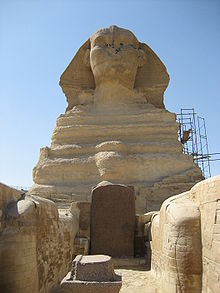Sphinx stele of Thutmose IV.
The Sphinx stela of Thutmose IV. (Often dream Tele is called) one of rose granite made Stele , which the king ( Pharaoh ) Thutmose IV. Between the front paws of the Sphinx had erected.
content
Dating
Thutmose IV wrote the stele text around 1400 BC. BC (dating after Rolf Krauss) or 1388 BC. BC (dating from Wolfgang Helck ) in his first year of reign, in the 3rd month of the Achet season, on the 19th day after he had initially not told anyone about his visit to the Sphinx monument and then after taking up his reign freed the Sphinx from the sand and covered his front paws with large blocks of limestone to protect him from wind erosion .
Texts

The dream stele tells an incident that happened to the later King Thutmose IV as a youth. He was on the hunt with only one of his confidants, and at noon he rested in the shadow of the Sphinx. He fell asleep and woke up to God's address:
“His Majesty (Thutmose IV.) Was a child like Horus, who was a child in Chemmis , but his perfection was like that of the one who avenges his father. He (Thutmose IV.) But drove sport by in the desert of Memphis hilarious ... without anyone knowing ... That day it happened ... the sleep and slumber had him taken standing in the middle as the sun overhead ... ( Harmachis-Chepre-Re-Atum speaking to Thutmose IV in his sleep): Look at me, look at me, my son Thutmose. I am your father Harmachis-Chepre-Re-Atum, who gives you the kingdom on earth at the head of the living. "
The god goes on with the promise of the kingdom, and then closes the lament that it is covered in great masses of sand. He asks that Thutmose set him free:
“The sand of the desert on which I am standing is approaching me. I have waited for you to do what is in my heart, knowing that you are my son and protector. Approach, I am the one who guides you. "
In the specialist Egyptological literature, the deity Harachbit - the ancient Egyptian name of Horus in its manifestation as an adolescent child on the " floating island of Chemmis " - is very often rendered as " Harpokrates ". However, the inscription expressly mentions "Horus in Chemmis". The equation with Harpocrates, which is also used for other Horus child gods, is therefore to be understood as an anachronistic generic term and not as a literal translation.
See also
literature
- Rolf Gundlach: From the end of Amenhotep II to the age of majority Amenhotep III. The turn from foreign policy to domestic policy in the early Voramarna period reflected in the royal ideology. In: Rolf Gundlach, Andrea Klug (ed.): The Egyptian kingship in the field of tension between domestic and foreign policy in the 2nd millennium BC Chr. Harrassowitz, Wiesbaden, 2004, pp. 119–220.
- Georg Steindorff, Siegfried Schott; edited by Wolfgang Helck: Documents of the 18th Dynasty . Ed .: Hermann Grapow. Issue 19. Akademie-Verlag, Berlin 1957, Sphinx stele Thutmisis IV., P. 1539–1544 ( digitized [accessed March 10, 2016]).
- Andrea Klug: Royal steles in the time from Ahmose to Amenophis III (= Monumenta Aegyptiaca 8). Brepols, Turnhout 2002, ISBN 2-503-99123-8 , pp. 296-304 (also: Mainz, Univ., Diss., 1998).
- Christian Leitz et al. (Hrsg.): Lexicon of the Egyptian gods and names of gods . (LGG). Volume 5: Ḥ - ḫ (= Orientalia Lovaniensia analecta. (OLA). 114). Peeters, Leuven et al. 2002, ISBN 90-429-1150-6 , p. 238.
- Sandra Sandri: Har-Pa-Chered (Harpokrates). The genesis of an Egyptian child of gods (= Orientalia Lovaniensia analecta. 151). Peeters, Leuven et al. 2006, ISBN 90-429-1761-X .
Web links
Individual evidence
- ^ Rolf Gundlach: From the end of Amenhotep II to the age of majority Amenhotep III. The turn from foreign policy to domestic policy in the early Voramarna period reflected in the royal ideology. In: Rolf Gundlach, Andrea Klug (ed.): The Egyptian kingship in the field of tension between domestic and foreign policy in the 2nd millennium BC Chr. Harrassowitz, Wiesbaden, 2004, p. 134.
- ↑ Sandra Sandri: Har-Pa-Chered (Harpokrates) (= Orientalia Lovaniensia analecta. Volume 151). Peeters Publishers, 2006, ISBN 90-429-1761-X , p. 11 ( at books.google.de ).

